Abstract
OBJECTIVE: To investigate the effects of long term (> 10 years) endurance training and submaximal exercise on the phagocytic activity of circulating neutrophil granulocytes. METHODS: The ability of stimulated blood neutrophils isolated from well trained cyclists [n = 8; VO2max 61.0(SD 8.8) ml.kg-1.min-1; age 38(4) years] and age matched sedentary controls [n = 8; VO2max 37.4 (6.6) ml.kg-1.min-1] to ingest nitroblue tetrazolium was assessed at rest and following a standardised submaximal bout of exercise on a cycle ergometer. RESULTS: Trained subjects had a lower resting blood neutrophil count (P < 0.01). Acute exercise caused a rise (P < 0.01) in the blood neutrophil count irrespective of training status, but the magnitude of the rise was smaller in the trained subjects (P < 0.05). The circulating neutrophil phagocytic capacity was approximately 70% lower in trained individuals at rest compared with the control subjects (P < 0.01). Acute submaximal exercise increased this variable in both groups, but phagocytic capacity remained substantially lower in the trained subjects compared with the controls (P < 0.05) despite the observation that a higher proportion of the circulating neutrophils were stimulated to undergo phagocytosis in the trained subjects [57(14)% v 32(7)%; P < 0.01). CONCLUSIONS: Although neutrophil phagocytic activity is only one variable that contributes to immunological status, prolonged periods of endurance training may lead to increased susceptibility to opportunistic infections by diminishing this activity at rest.
Full text
PDF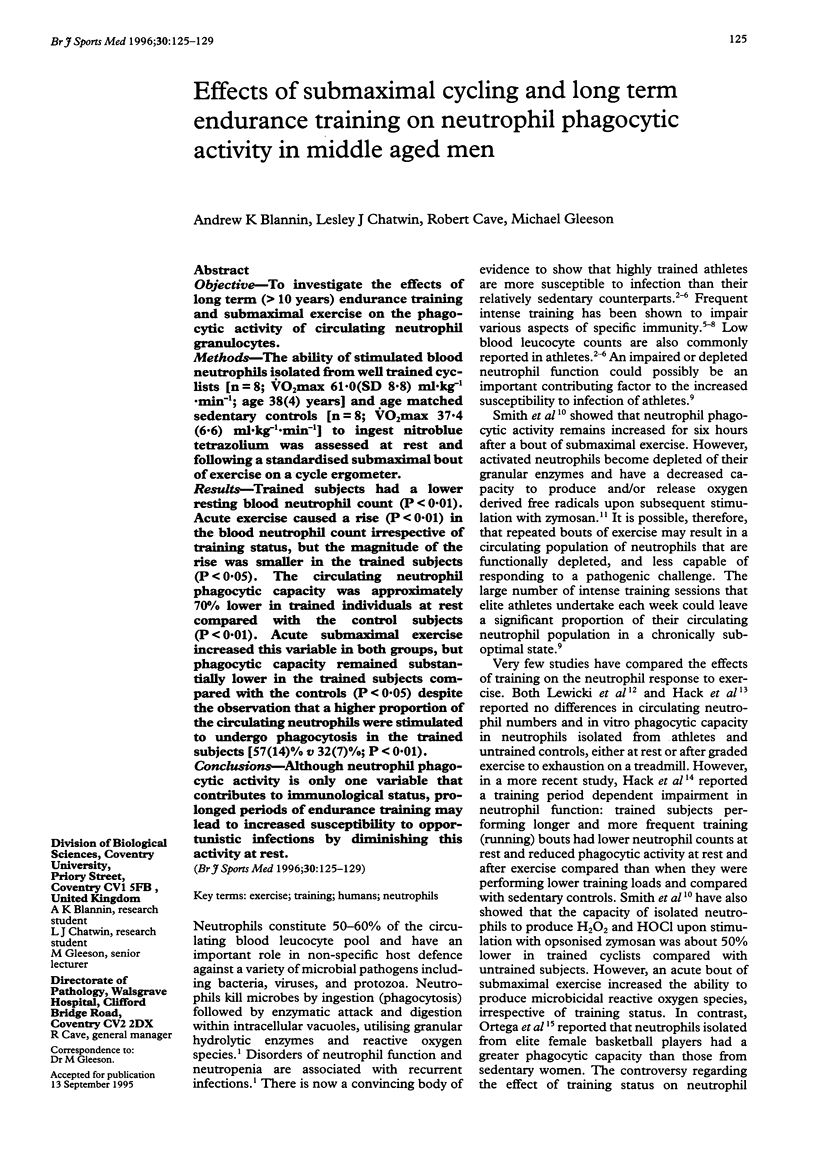
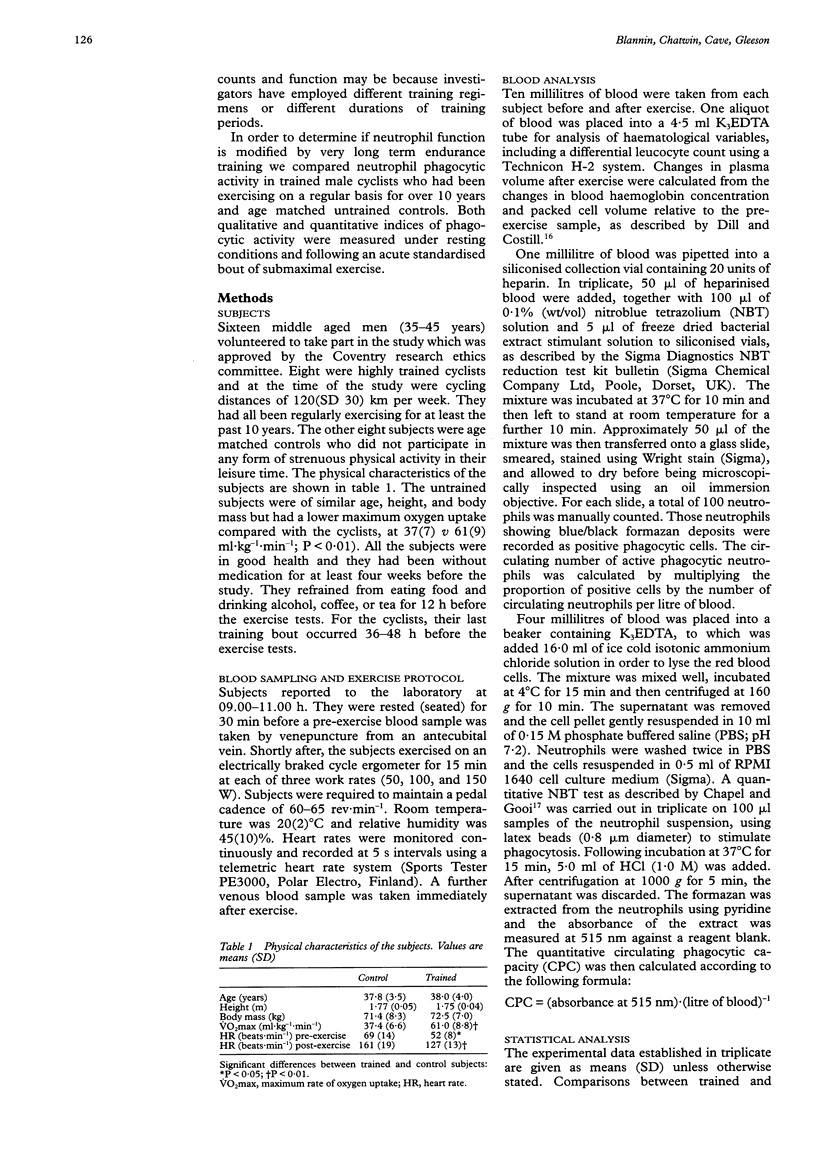
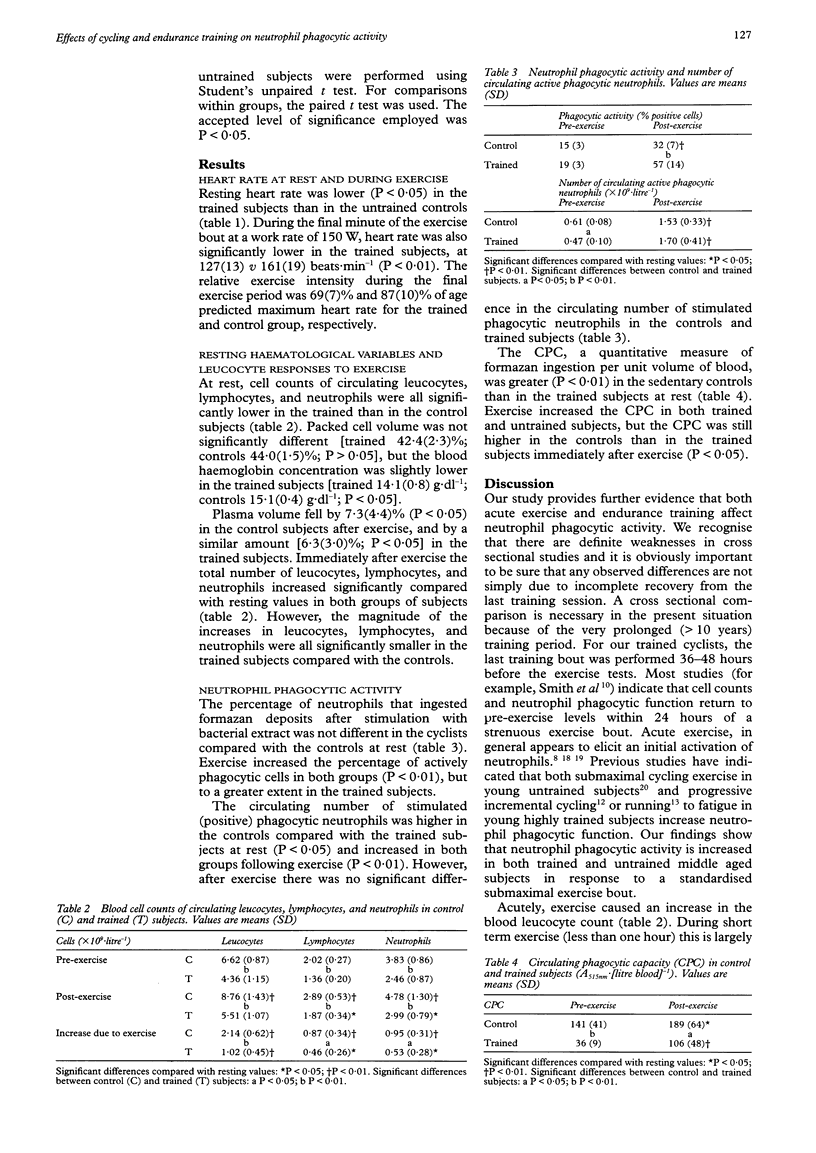
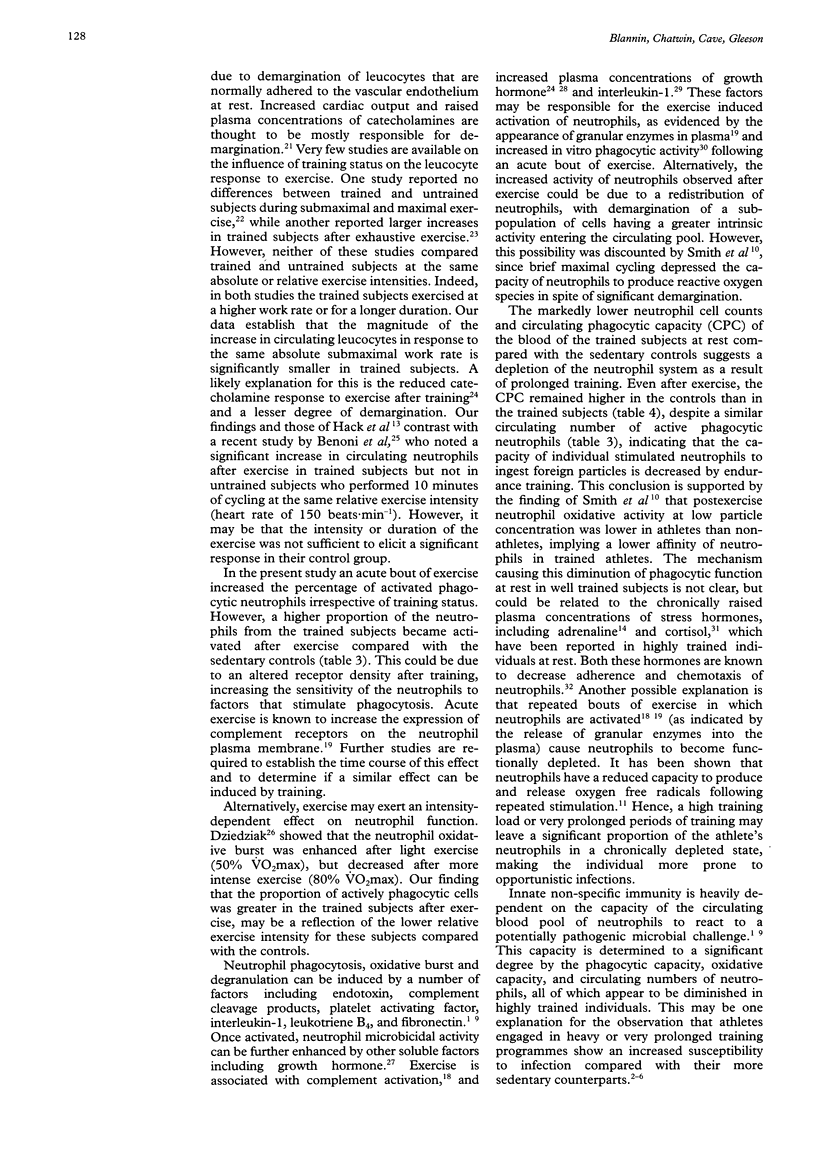
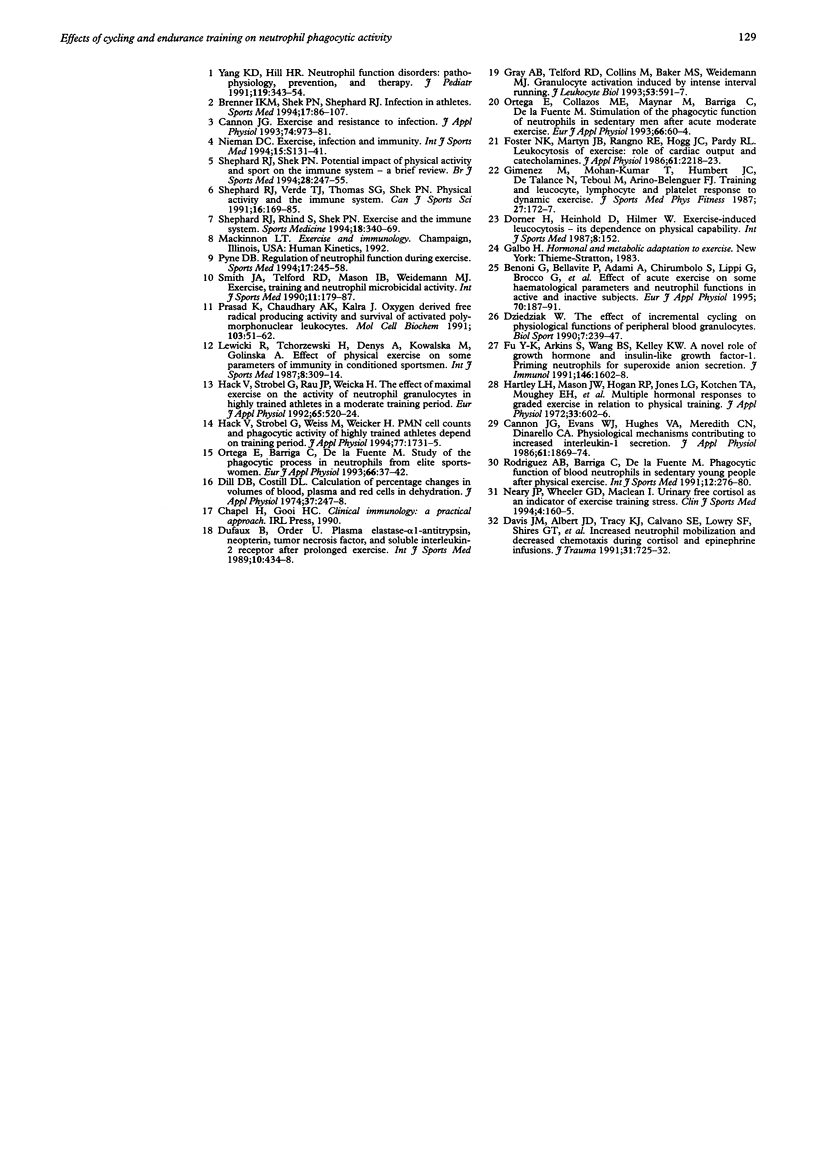
Selected References
These references are in PubMed. This may not be the complete list of references from this article.
- Benoni G., Bellavite P., Adami A., Chirumbolo S., Lippi G., Brocco G., Cuzzolin L. Effect of acute exercise on some haematological parameters and neutrophil functions in active and inactive subjects. Eur J Appl Physiol Occup Physiol. 1995;70(2):187–191. doi: 10.1007/BF00361548. [DOI] [PubMed] [Google Scholar]
- Brenner I. K., Shek P. N., Shephard R. J. Infection in athletes. Sports Med. 1994 Feb;17(2):86–107. doi: 10.2165/00007256-199417020-00002. [DOI] [PMC free article] [PubMed] [Google Scholar]
- Cannon J. G., Evans W. J., Hughes V. A., Meredith C. N., Dinarello C. A. Physiological mechanisms contributing to increased interleukin-1 secretion. J Appl Physiol (1985) 1986 Nov;61(5):1869–1874. doi: 10.1152/jappl.1986.61.5.1869. [DOI] [PubMed] [Google Scholar]
- Cannon J. G. Exercise and resistance to infection. J Appl Physiol (1985) 1993 Mar;74(3):973–981. doi: 10.1152/jappl.1993.74.3.973. [DOI] [PubMed] [Google Scholar]
- Davis J. M., Albert J. D., Tracy K. J., Calvano S. E., Lowry S. F., Shires G. T., Yurt R. W. Increased neutrophil mobilization and decreased chemotaxis during cortisol and epinephrine infusions. J Trauma. 1991 Jun;31(6):725–732. [PubMed] [Google Scholar]
- Dill D. B., Costill D. L. Calculation of percentage changes in volumes of blood, plasma, and red cells in dehydration. J Appl Physiol. 1974 Aug;37(2):247–248. doi: 10.1152/jappl.1974.37.2.247. [DOI] [PubMed] [Google Scholar]
- Dufaux B., Order U. Plasma elastase-alpha 1-antitrypsin, neopterin, tumor necrosis factor, and soluble interleukin-2 receptor after prolonged exercise. Int J Sports Med. 1989 Dec;10(6):434–438. doi: 10.1055/s-2007-1024939. [DOI] [PubMed] [Google Scholar]
- Foster N. K., Martyn J. B., Rangno R. E., Hogg J. C., Pardy R. L. Leukocytosis of exercise: role of cardiac output and catecholamines. J Appl Physiol (1985) 1986 Dec;61(6):2218–2223. doi: 10.1152/jappl.1986.61.6.2218. [DOI] [PubMed] [Google Scholar]
- Fu Y. K., Arkins S., Wang B. S., Kelley K. W. A novel role of growth hormone and insulin-like growth factor-I. Priming neutrophils for superoxide anion secretion. J Immunol. 1991 Mar 1;146(5):1602–1608. [PubMed] [Google Scholar]
- Gimenez M., Mohan-Kumar T., Humbert J. C., De Talance N., Teboul M., Ariño Belenguer F. J. Training and leucocyte, lymphocyte and platelet response to dynamic exercise. J Sports Med Phys Fitness. 1987 Jun;27(2):172–177. [PubMed] [Google Scholar]
- Gray A. B., Telford R. D., Collins M., Baker M. S., Weidemann M. J. Granulocyte activation induced by intense interval running. J Leukoc Biol. 1993 May;53(5):591–597. doi: 10.1002/jlb.53.5.591. [DOI] [PubMed] [Google Scholar]
- Hack V., Strobel G., Rau J. P., Weicker H. The effect of maximal exercise on the activity of neutrophil granulocytes in highly trained athletes in a moderate training period. Eur J Appl Physiol Occup Physiol. 1992;65(6):520–524. doi: 10.1007/BF00602358. [DOI] [PubMed] [Google Scholar]
- Hack V., Strobel G., Weiss M., Weicker H. PMN cell counts and phagocytic activity of highly trained athletes depend on training period. J Appl Physiol (1985) 1994 Oct;77(4):1731–1735. doi: 10.1152/jappl.1994.77.4.1731. [DOI] [PubMed] [Google Scholar]
- Hartley L. H., Mason J. W., Hogan R. P., Jones L. G., Kotchen T. A., Mougey E. H., Wherry F. E., Pennington L. L., Ricketts P. T. Multiple hormonal responses to graded exercise in relation to physical training. J Appl Physiol. 1972 Nov;33(5):602–606. doi: 10.1152/jappl.1972.33.5.602. [DOI] [PubMed] [Google Scholar]
- Lewicki R., Tchórzewski H., Denys A., Kowalska M., Golińska A. Effect of physical exercise on some parameters of immunity in conditioned sportsmen. Int J Sports Med. 1987 Oct;8(5):309–314. doi: 10.1055/s-2008-1025675. [DOI] [PubMed] [Google Scholar]
- Nieman D. C. Exercise, infection, and immunity. Int J Sports Med. 1994 Oct;15 (Suppl 3):S131–S141. doi: 10.1055/s-2007-1021128. [DOI] [PubMed] [Google Scholar]
- Ortega E., Barriga C., De la Fuente M. Study of the phagocytic process in neutrophils from elite sportswomen. Eur J Appl Physiol Occup Physiol. 1993;66(1):37–42. doi: 10.1007/BF00863397. [DOI] [PubMed] [Google Scholar]
- Ortega E., Collazos M. E., Maynar M., Barriga C., De la Fuente M. Stimulation of the phagocytic function of neutrophils in sedentary men after acute moderate exercise. Eur J Appl Physiol Occup Physiol. 1993;66(1):60–64. doi: 10.1007/BF00863401. [DOI] [PubMed] [Google Scholar]
- Prasad K., Chaudhary A. K., Kalra J. Oxygen-derived free radicals producing activity and survival of activated polymorphonuclear leukocytes. Mol Cell Biochem. 1991 Apr 24;103(1):51–62. doi: 10.1007/BF00229593. [DOI] [PubMed] [Google Scholar]
- Pyne D. B. Regulation of neutrophil function during exercise. Sports Med. 1994 Apr;17(4):245–258. doi: 10.2165/00007256-199417040-00005. [DOI] [PubMed] [Google Scholar]
- Rodriguez A. B., Barriga C., De la Fuente M. Phagocytic function of blood neutrophils in sedentary young people after physical exercise. Int J Sports Med. 1991 Jun;12(3):276–280. doi: 10.1055/s-2007-1024680. [DOI] [PubMed] [Google Scholar]
- Shephard R. J., Rhind S., Shek P. N. Exercise and the immune system. Natural killer cells, interleukins and related responses. Sports Med. 1994 Nov;18(5):340–369. doi: 10.2165/00007256-199418050-00006. [DOI] [PubMed] [Google Scholar]
- Shephard R. J., Shek P. N. Potential impact of physical activity and sport on the immune system--a brief review. Br J Sports Med. 1994 Dec;28(4):247–255. doi: 10.1136/bjsm.28.4.247. [DOI] [PMC free article] [PubMed] [Google Scholar]
- Shephard R. J., Verde T. J., Thomas S. G., Shek P. Physical activity and the immune system. Can J Sport Sci. 1991 Sep;16(3):169–185. [PubMed] [Google Scholar]
- Smith J. A., Telford R. D., Mason I. B., Weidemann M. J. Exercise, training and neutrophil microbicidal activity. Int J Sports Med. 1990 Jun;11(3):179–187. doi: 10.1055/s-2007-1024788. [DOI] [PubMed] [Google Scholar]


